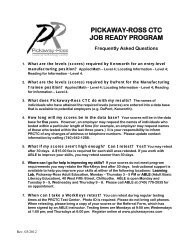Commons
Conceptual Physics - elearning-phys
Conceptual Physics - elearning-phys
- No tags were found...
Create successful ePaper yourself
Turn your PDF publications into a flip-book with our unique Google optimized e-Paper software.
to the egg.Luckily, we now know enough to investigate a different suspectas a candidate for the atomic force: electricity. Electric forces areoften observed between objects that have been prepared by rubbing(or other surface interactions), for instance when clothes rub againsteach other in the dryer. A useful example is shown in figure 5.1/1:stick two pieces of tape on a tabletop, and then put two more pieceson top of them. Lift each pair from the table, and then separatethem. The two top pieces will then repel each other, 5.1/2, aswill the two bottom pieces. A bottom piece will attract a top piece,however, 5.1/3. Electrical forces like these are similar in certain waysto gravity, the other force that we already know to be fundamental:• Electrical forces are universal. Although some substances,such as fur, rubber, and plastic, respond more strongly toelectrical preparation than others, all matter participates inelectrical forces to some degree. There is no such thing as a“nonelectric” substance. Matter is both inherently gravitationaland inherently electrical.• Experiments show that the electrical force, like the gravitationalforce, is an inverse square force. That is, the electricalforce between two spheres is proportional to 1/r 2 , where r isthe center-to-center distance between them.a / Four pieces of tape areprepared, 1, as described in thetext. Depending on which combinationis tested, the interactioncan be either repulsive, 2, orattractive, 3.Furthermore, electrical forces make more sense than gravity ascandidates for the fundamental force between atoms, because wehave observed that they can be either attractive or repulsive.5.2 Charge, Electricity and MagnetismCharge“Charge” is the technical term used to indicate that an objectparticipates in electrical forces. This is to be distinguished fromthe common usage, in which the term is used indiscriminately foranything electrical. For example, although we speak colloquially of“charging” a battery, you may easily verify that a battery has nocharge in the technical sense, e.g., it does not exert any electricalforce on a piece of tape that has been prepared as described insection 5.1.Two types of chargeWe can easily collect reams of data on electrical forces betweendifferent substances that have been charged in different ways. Wefind for example that cat fur prepared by rubbing against rabbitfur will attract glass that has been rubbed on silk. How can wemake any sense of all this information? A vast simplification isSection 5.2 Charge, Electricity and Magnetism 97



